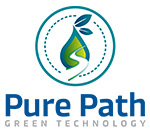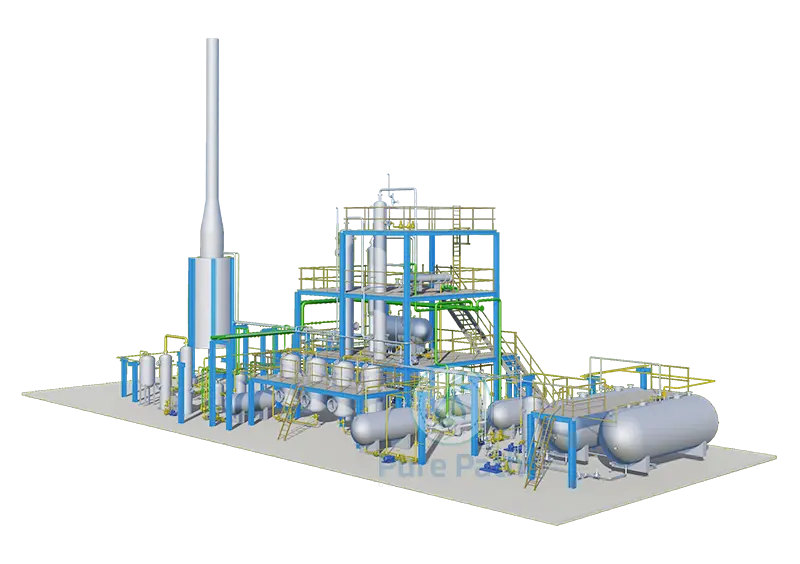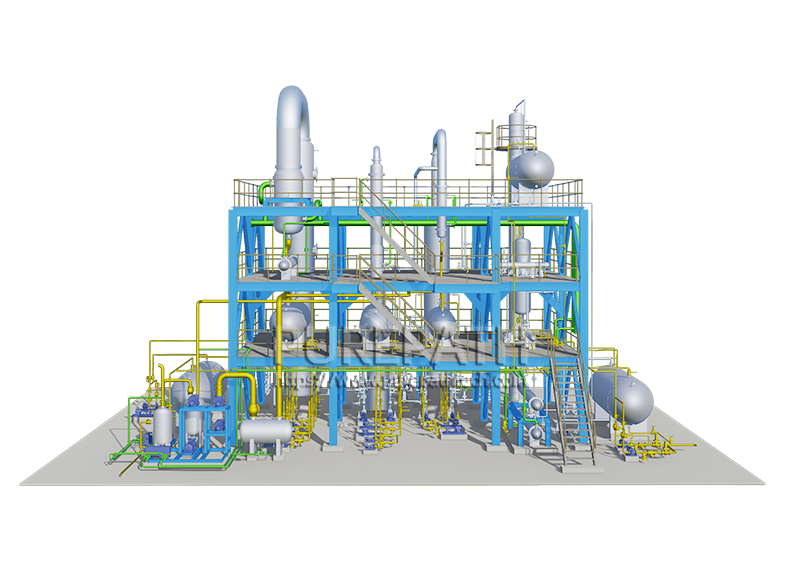Used Oil Purification: Turning Pollution into a Valuable Resource
Introduction: From Burning to Recycling — A Better Way to Handle Used Motor Oil
The used motor oil disposal is one that causes great concern for the environment. Whenever someone is deciding how to deal with the used motor oil that is a common ‘automotive byproduct’, the question arises: Is it legal to burn used motor oil? The answer is yes, in most places, the engine oil is heavily law-regulated, and burning it without special care is illegal. And the reason for this is that during the unnecessary burning of oil, a large amount of toxic to the surrounding population. And those include heavy metals like lead and cadmium, poisonous organic compounds, and all the way to cancerous compounds such as dioxins.
Restoration of the used motor oil serves a far more valuable purpose. Instead of burning, which is damaging to the environment and illegal, recycle waste motor oil. The system of changing used engine oil to a valuable oil resource offers a sustainable and highly beneficial opportunity. Used oil purification is critical and economically viable, offering used engine oil for recycling. The used oil is able to be transformed, which offers a range of renewed and the purpose of this article is transformative uses.

Part 1: Why Burning Used Oil Is Environmentally Dangerous
Used motor oil is definitely not a greasy liquid. It is a multi-layered, highly complex mixture of a base oil, usually hydrocarbon blends, as well as a wide range of fine metallic and non-metallic contaminants originating from particles, as well as water and oxidized hydrocarbons. These contaminants accumulated during the operation of the motor engine, and there is also a possibility of degraded additive packages, made of dispersants, detergents, and anti-wear agents, that are all manufactured with the intention of improving engine functionality.
When burned, the mixture releases a huge cloud of emissions, and the subsequent gas is greatly dangerous. There is particulate matter, Sulphur Dioxide, and oxides of heavy metals, all of which greatly deteriorate air and contribute to numerous lung-related illnesses. The hydrocarbons that are incompletely burned also give rise to polycyclic aromatic hydrocarbons, and some of them are very highly carcinogenic. Simply due to the legal and humanitarian reasons, or lack thereof, the environmental regulations of the developed countries across the world always supersede the need for used oil purification, which is now termed as the more responsible method.
Part 2: What Is Used Oil Purification?
Used oil purification is a series of thermo-physical and chemical operations that separate the waste products (water, oxidation residues, solid particles, and volatile contaminants) from the used oil and make it reusable. It is the cornerstone of how to recycle used engine oil.
Purification can be broken down into sub-categories depending on the level of treatment:
- Light Purification / Filtration: Removing free water and large solid particles in order to make the oil reusable in less important operations, or usable in other processes.
- Advanced re-refining: More sophisticated processes, which include vacuum distillation, hydrotreating, and solvent extraction to create a re-refined base oil that meets the API regulations for a base oil lubricant.
Common equipment integral to these processes includes:
- Dehydrators and Vacuum Oil Purifiers: Using heat and negative pressure to effectively strip water and light hydrocarbons.
- Waste Oil Regeneration Units: Self contained multi-stage systems which include chemical treatment and or fractional distillation.
- Centrifugal Separators and Heating Systems: Mechanically remove suspended solid particles and prepare the oil for the other stages.
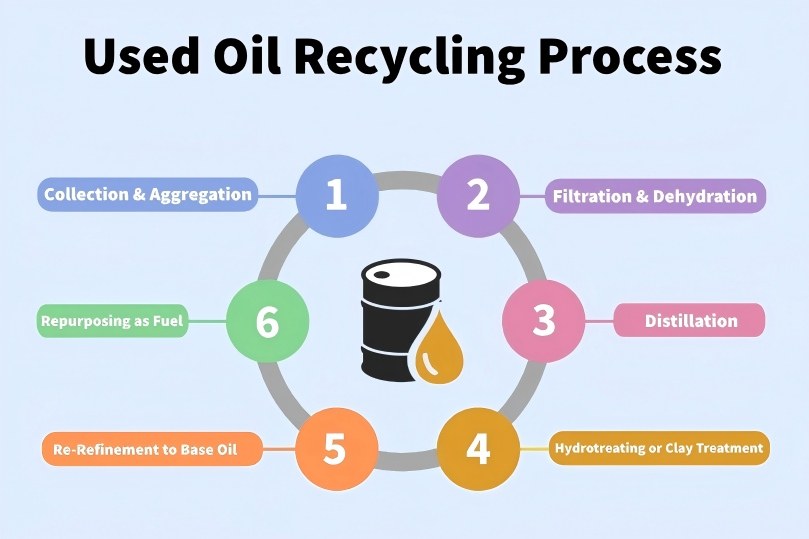
Part 3: Main Stages of Used Oil Purification
Like every recycling process, as well as the recycling of waste engine oil, follows a specific multi-step procedure to improve the quality of oil.
1. Pre-Filtration and Dehydration
This step removes any large debris and free water. Pre-filters shield equipment at the downstream, whereas dehydration with the use of heat, separated with a vacuum, is a must. The use of a vacuum lowers the boiling point of water. This enables water to vaporize without any destructive temperature, and enables oil to dematerialize in a safe way.
2. Degassing and Deacidification
This step targets any volatile compounds, such as solvents, gasoline, or any acid from oxidation. Milder hydrocarbons are pulled using a vacuum in a process called ‘Degassing’ due to the presence of de-gassing oil. Neutralizing and removing corrosive class, deacidification is achieved through chemical treatment or any special adsorptive media. This protects the machinery and the oil to increase its stability.
3. Fine Filtration and Improvement of Color
Fine carbon and sludge particles, which are suspended in the fluid, are removed by ultra-fine filters, which are rated in microns. To enhance the oil’s clarity and deter its instability, it can be processed through adsorbent media, including but not limited to, activated clay and bauxite. These adsorbents eliminate certain polar constituents that cause the oil to be discolored and unstable.
4. Re-refining (Advanced Regeneration)
To achieve the best results, re-refining the oil is a common practice. This frequently includes the use of thin-film evaporation or vacuum distillation in order to isolate the lubricating oil fractions from the spent additives and heavy residues (asphaltic materials). The distillate obtained is now subjected to a final polishing step, usually in the form of hydrotreating, and the oil can undergo in-depth hydrocracking to achieve a virgin quality euro base oil, and the impurities will be removed at a molecular level.
Part 4: Environmental and Economic Benefits
The transition from burning to purification offers a compelling array of benefits:
- Economic Protection: Processing oil used through approved routes eliminates millions of gallons from landfills, illegal dumps, and systems, greatly reducing both land and water pollution, as well as air contamination.
- Resource Recovery: The re-refined and purified oil becomes a substitute for virgin-based oil obtained from petroleum and, therefore, supports sustainable resource management.
- Energy Saving: The process used for re-refining base oil, as opposed to using crude oil, requires 85% less energy, making it a much more efficient process.
- Legal Compliance: Professional waste engine oil recycling services cut across various industries and, as such, promote compliance with environmental requirements, reducing the likelihood of businesses paying fines and accruing legal obligations.
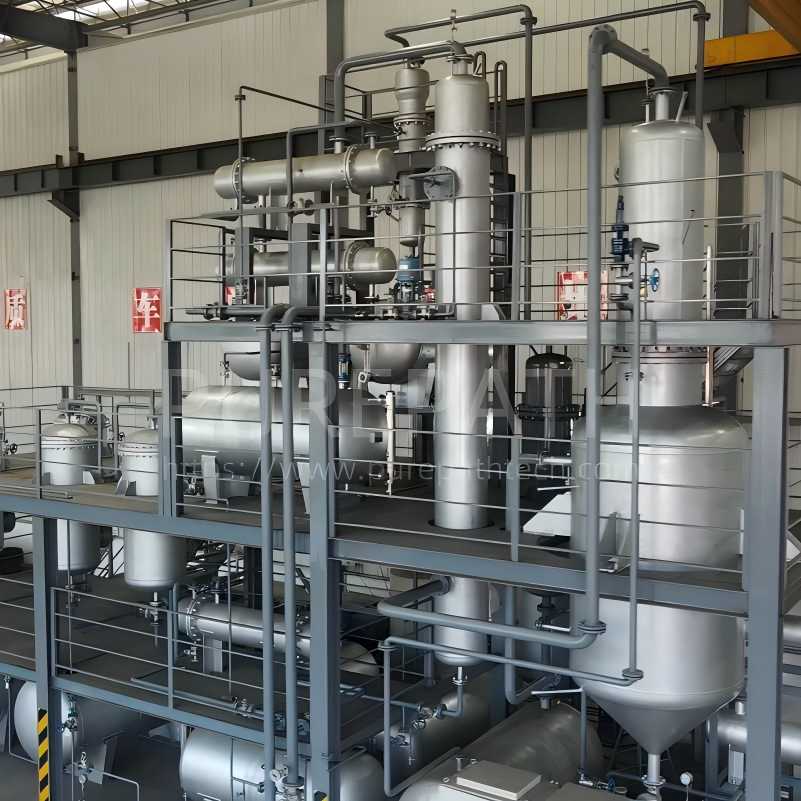
Part 5: Modern Used Oil Purification Technologies
Modern purification technologies are highly efficient and often automated:
- Vacuum Dehydration Systems: These newly developed units keep heat and pressure controls sophisticated to attain moisture content below 50ppm. This is extremely important for high performance lubricants.
- Centrifugal Separation: In both the pre-treatment and intermediate stages, high-speed centrifuges provide the fastest, continuous, and chemical-free method of separating the solid and water phases. They are a valuable asset.
- Hydrotreating & Solvent Extraction: These methods are sophisticated and allow re-refineries to improve the quality of base oil fractions. They help meet the challenging specifications of the API base oil Groups II and III.
- Automation and Monitoring: Intelligent control systems are used in automated plants to take real-time measurements of temperature, pressure, and flow. This ensures safe and steady optimal conditions throughout the entire process.
Conclusion: Turning Waste into Resource
Disposing of used motor oil by burning it poses both legal and difficult challenges; however, the alternative of recycling it poses other choices: It is either destruction of the environment or the alternative–sustainability. This is why the thorough and responsible purification of waste oil helps us comply with waste environmental regulations while also enhancing the circular economy. We are able to transform toxic and hazardous waste products into a distinct resource and balance the circle of lubricant usage.
Used oil purification is not just a simple recycling process; it is the modern take on redefining responsibility as well as taking waste, converting it into a resource, and creating an opportunity.
